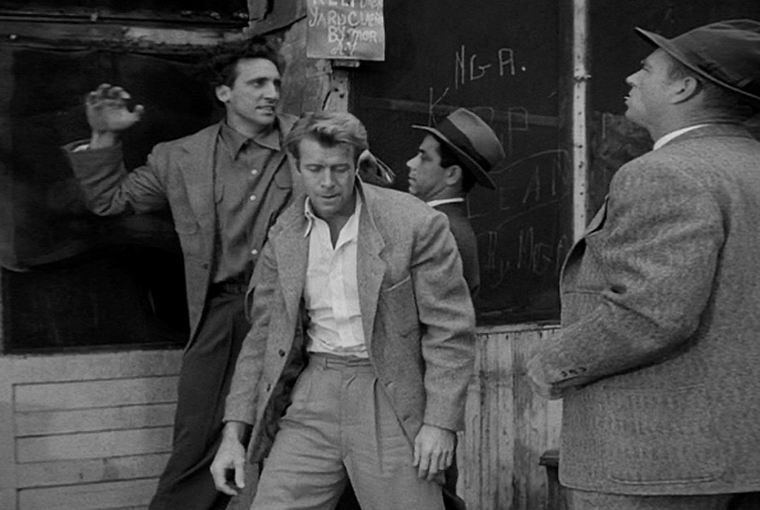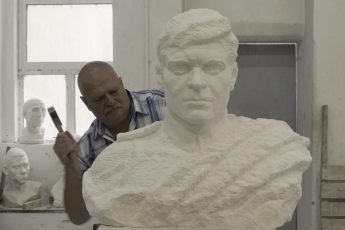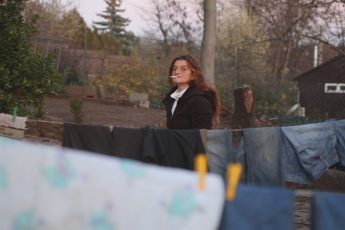
Andre de Toth’s Crime Wave (1954) starts appropriately for a film noir, with the camera panning over nocturnal city traffic from the backseat of a moving car. When the car stops at a gas station and the passenger gets out, the camera lingers in the backseat, giving a “peeping tom” view of the interaction through the car window. A friendly gas station employee (facing the camera) says hello through the station window; the passenger (face ominously still hidden) does not. As the employee blithely explains his love for the Doris Day record, the camera crew (and the spectator) seem to know better – suspicion confirmed when the silent shadowed passenger attacks. A brilliant hold-up scene to the music of Doris Day.
Thus opens a concise and fast-moving 73-minute classic film noir. After the expertly filmed gas station hold-up which begins the film (and is perhaps the most rewarding cinematographically), we follow one of the three hold-up men who’s been shot and escapes into residential Glenwood (Los Angeles). We’re then introduced to the main character, Steve Lacey (Gene Nelson), who receives a call from the gangster. Lacey’s wife Ellen (Phyllis Kirk) gently expresses her concern, and in 30 seconds the spectator knows the essentials: Lacey, ex-con-turned-virtuous, has been trying to “make it good” with wife, faithful parole officer, and a job as an airline mechanic, but has a well-founded fear of his old associates from the San Quentin penitentiary who constantly call him. The Manichean plot follows accordingly. The gangsters force the couple into harboring them and assisting in a bank robbery, the police express contempt and distrust for Lacey “once a con, always a con”, the loyal parole officer believes otherwise, and Lacey plays the good man fighting against an unjust police system and the scoundrels of his past.
Crime Wave has a surprising number of moments of cinematic ingenuity, a powerful and cutting-edge representation of sexuality, and an underlying concern with bureaucracy and technology that takes it a (small) step beyond the wealth of other film noir shot in under two weeks for a minimal budget.
For a film made in 1952, the sexuality accorded to the gangsters and to Phyllis Kirk, the only female character, is troubling and intense. In one of her first scenes, we see the bedside telephone ring, and without dialogue, the camera shows Steve Lacey’s hand reach for it and Ellen’s hand – from below – hold his back. A small gesture, but the camera lingers just long enough for the spectator to make the proper conjugal references. Ellen Lacey’s character seems to center around her dual identity as respectable (verified by the parole officer and her husband) and as a passive sexualized object, implicitly sexually threatened by the gangsters both to keep Lacey in a state of tension and to force him to help them. The couple’s household is penetrated by the gangsters at night, Lacey is forced out of their bed to welcome them, they eat the steaks the couple bought for a romantic dinner, and Lacey’s wife is forced to serve them. If the violation of domestic life was not enough, the gangsters sediment their role as the bad guys with constant comments on her appearance via compliments to Lacey. During a final scene in which Lacey must leave the house to drive a getaway car for a bank robbery, his wife is left to be “baby-sat” by a leering gangster alone in the house, a moment so psychologically frightening it seems almost out of place in a B-budget film noir. Sure, the gender roles are strict and traditional, even over-done, but their exaggeration is compelling and the result, scandalous even for our era.
Otherwise, the film is almost entirely filmed at night, with the exception of the bank robbery, and a daylight scene of Lacey and his wife returning from work in a state of domestic bliss, a touch that makes the dark film literally even darker. The film repeatedly shows scenes of police communication via telephone operators and radio dispatches, almost always disseminating incorrect information vilifying our brave ex-con protagonist, and telephone calls are not represented any better. We see Lacey’s dutiful wife chastising Lacey on his many calls from relentless former prison-mates, several scenes before the parole officer’s wife (in her only scene) chastises him on receiving late-night calls from his relentless ex-con parolees, also referred to in a derogative manner. Phone and radio seem to connect the characters against their will, and the phone book plays a vital rôle in permitting the harmful identification and contact between good guys and gangsters. Modernity seems only to be a benefit for the proliferation of crime, and the eventual triumph of good is performed through the simple act of leaving a written note.
Hungarian-American director Andre de Toth, one-time husband of Veronica Lake, is otherwise best known for directing one of the first feature-length 3-D films, House of Wax, also starring Phyllis Kirk. His background in the Hungarian theater scene is evident in both, as his strengths seem to reside in a particularly theatrical use of lighting and music. And although his antagonists may seem too rotten to be true, the source of his inspiration may come from close to home. In an interview, his own diction seems to mirror a 1950s gangster: “Spielberg always had the talent but no guts, only chutzpah. He lived audaciously, in children’s glossy and well-playing dreams” (Anthony Slide, De Toth on De Toth: Putting the drama in front of the camera, Faber : 1996). In comparison to Spielberg, de Toth seems to identify as living in a dark adult world. Perhaps Crime Wave, where technology, gender roles, police and criminals oppress the human element, is not just a film noir, but a representation of de Toth’s noir reality.




Leave a Comment